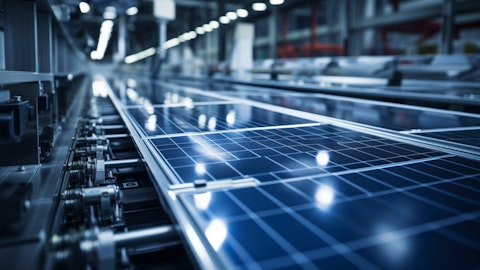But all of those are largely behind us, and we issued a 8-K in December of 2023. In addition, what we did at that time was we announced that we are shutting down Romania as well as Wisconsin, it didn’t makes sense for us to have 10 million microinverters per quarter and it remaining capacity. And therefore, we work with the manufacturers and we had to be fair to them. And therefore, we essentially reduced our capacity from 10 to approximately seven. And so that’s what we did, and we announced that change as well. So Mandy, why don’t you elaborate on the…
Mandy Yang: Sure. Yes. So our OpEx we reduced from — non-GAAP OpEx reduced from $99 million in Q3, right, to $86 million in Q4, right? And that was before the restructuring effect that that will come into effect in Q1 and Q2, right? But throughout 2023, we have been reducing discretionary spend, right, and also hiring freeze, right. And even attrition, we don’t backfill. We only backfill critical ones, right? And that’s why we got our OpEx to reduce from $99 million to $86 million, right? But in December, we implemented a restructuring plan, right? We further reduced our worldwide headcount full-time employees and contractors, right, by 10%. So with that, once those restructuring actions are completed by Q2, we would be at $75 million to $80 million run rate a quarter.
Colin Rusch: Okay. That’s super helpful. And then just from a pricing perspective, you talked about kind of select discounts for folks in the past. Can you give us a sense of how that’s trending here even if the list prices are stable, what sort of discounts you’re having to offer up to folks? And if there’s any sort of dynamics around evolution of the product driving some incremental price benefit for the company?
Badri Kothandaraman: No, there is — I said the same last quarter, I say the same now. This has been ever since I took over this, we have always had the special pricing adjustment business process. And we do manage that very tightly across the company. And so there has been notably not much change in general in the pricing environment, and that should be kind of obvious to see based on our gross margins as well.
Operator: The next question comes from Julien Dumoulin-Smith of Bank of America. Please go ahead.
Julien Dumoulin-Smith: Hey, good afternoon. Thanks team and nice inflection. So just in terms of the 0.5 million shipments here in 1Q here, can you talk a little bit about how you plan to scale up to the $5 billion capacity, have you issued the 8-K here, kind of bringing down overall manufacturing. But can you talk about how you anticipate that ramping here, if you will. And then maybe in tandem with that implicit, how do you see underlying demand trending vis-à-vis kind of returning to that $500 million and then back up to say $700 million or what have you?
Badri Kothandaraman: Right. So just to set context, we shipped approximately 900,000 units from our U.S. factories in Q4. So why are we going back to 500,000 in Q1. That’s the first question to answer. To answer that one. It’s basically we are focused our inventory in terms of dollars, gross value of our inventory is about $200 million, $210 million roughly. And we think that inventory is high. That corresponds to 110 days of inventory, I think, and we think that the number of days of inventory is high, so we are going on a war path to reduce that to a best-in-class level. I consider the best-in-class level at 30 days. So we — that’s [indiscernible]. We are going back to 30 days. That means we are going to be ensuring that we don’t do any unnecessary manufacturing.
So that’s — based on that, our first priority is to get that — set that boat right. And so that’s why we said, okay, in the first half of the year, we would essentially do whatever it takes to clear the factory inventory and clear the channel. So you should expect lower shipments in the first half. In the second half, which is where if the demand approaches to, let’s say, for example, what you talked about, the $500 million level, that corresponds to approximately $3 million in — 3 point something million microinverters. You should expect two-thirds of those microinverters to be made in the U.S. And for example, if we get back to that $700 million run rate whenever it is, maybe in 2025, the — we are talking about $4.5 million to $5 million microinverters.
And you should again expect the same thing, two-thirds of that will be in the United States. So it is a strong function of demand. We have to balance both the factories inside and outside, and our balancing is two-thirds, one-thirds right.
Julien Dumoulin-Smith: Right. And maybe just a corresponding follow-up there briefly. Just the $130 million undershipped when you think about that being split again between U.S. and Europe, you talked about those two-thirds, one-thirds. How do you think about where that undership and the dynamic of that inventory being today and maybe perspective?
Badri Kothandaraman: Yes. For Q4, that was I would say, roughly it was, I would say 50-50 for Q4 between the U.S. and Europe. I think for Q1, it will be more tilted towards 60-40 U.S., Europe.
Operator: The next question comes from Philip Shen of Roth MKM. Please go ahead.
Philip Shen: Hi, everyone. Thanks for taking my questions. You highlighted that you think the destocking ends in Q2 now. But prior, you had talked about destocking ending at the end of Q1 and then before that, also by the end of ’23. What’s the probability and confidence in your call now that the destocking truly ends by the end of Q2? I don’t know if the answer is different to the U.S. market versus Europe. And then how does the impact of some of these meaningful shutdowns and bankruptcies impact you guys, and your confidence in your ability to say it’s Q2. You’ve been talking about this $450 million to $500 million run rate, but then ADT solar shutdown, Enphase Infinity vision, so how does that — are those dynamics? Because that number, $450 million, $500 million back in Q4 of last year when you had the Q3 call, these companies weren’t talking about going away or shutting down.
So does that — how has that impacted you, guys? Do you assume that others will just pick up the volume. And then we’re also watching closely what happens with the SunPower situation. So if that goes negative, what are your thoughts on how that can impact you to? Thanks.
Badri Kothandaraman: Yes. As far as the channel is concerned, in the October call, I was quite clear. I said we do expect to undership in both Q4 as well as Q1, and that’s right. And we did not — at that time, you are correct. I did say we could normalize in Q2. Now we executed on what we said for Q4. The $150 million, what I said, we did $147 million. We expect to do $130 million. We expect to do a much reduced level of undershipment in Q2. We don’t expect to do $130 million in Q2. We expect to be much reduced level. So we think the problem will go away for us in Q2, but I was conservative. I didn’t tell you by the end of Q2, and we are sticking with that. The next one, bankruptcies, how do bankruptcies effect? Bankruptcies are definitely causing some friction in the short term.
But I think what will happen in the industry is resilient. What happens is the — end customer demand doesn’t change. So therefore, it is a matter of time and it is unfortunate that these happened. However, these can be readily picked up. It might take a quarter as long as the end customer demand stays the same. We think other installers will pick it up. We have a diverse group of installers. We have — we worked with almost 1,500 installers in the U.S. And so there’s a lot of redundancy there. And so while you are correct, it is — it will cause some short-term friction. But I think that will soon disappear.
Philip Shen: Got it. Thanks. And then as you think about the difference between the U.S. and European markets, do you think — can you talk about the destocking situation there? When do you think that is done on a blended basis across the countries? And which region feels do you feel like it’s better for a faster recovery in U.S. or Europe? Thanks, Badri.
Badri Kothandaraman: I think at least our data, our forecasting calculation today show that Europe will be — will recover a little bit earlier by the end of Q1. I think we should see Europe doing a little better than the U.S. But I think both of them should be normalized in Q2.





